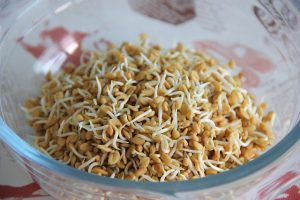
One of the hottest topics in culinary is using a technique called “sprouting”.
Sprouting is practiced in many parts of the world to improve the nutritional value of seeds, grains, nuts and legumes. Sprouting is when these food items are soaked between 24 hours and 3 days.
When I was young we learned to germinate or sprout seeds that were going into the garden using this technique.
To sprout seeds, grains, nuts or legumes, place the amount you want to use in a bowl and cover with water. Each day drain, rinse and replace the water with fresh. Usually, 3-5 days is all you need. This process also aids in digestion.
The process of sprouting has been said to increase nutrient content while decreasing anti-nutrients. This should provide many other health benefits. Antinutrients are plant compounds that reduce the body’s ability to absorb essential nutrients.
Antinutrients include calcium oxalate, lectins, tannins, which are a class of antioxidant polyphenols; protease inhibitors and phytate a.k.a. phytic acid.
Soaking and germinating are great methods for reducing these antinutrients. Below are some studies that show soaking will reduce these antinutrients by 9-30% They found this to be true with leafy greens as well, such as spinach.
Boiling, by far was the best technique to lower the antinutrients by more than 60%
Even better, use a combination of techniques like sprouting then boiling which can remove antinutrients by up to 95%.
Fermentation of food products such as yogurt, cheese, coffee, cocoa and soy sauce helps reduce antinutrients. How about making a batch of sourdough bread. Making this effectively degrades antinutrients in the grains, leading to an increased availability of nutrients.
Look at all of these studies showing that sprouting, soaking, fermentation and cooking grains reduce the bad stuff while increasing the availability of good things for our bodies. Plus, these naturally processed foods taste great and can be made with lots of variety.
Explore these food preparations and cooking techniques on grains, nuts, seeds and legumes and give us a response. Your body will thank you for it, especially your taste buds.
NIH article about how our bodies digest quinoa
Soaking, boiling, and antinutritional factors in peas
Phytate in food and significance for humans
Germination and fermentation of cereals
Effects of germination on soy-beans
